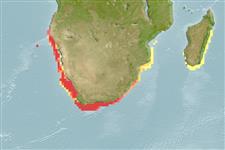Elasmobranchii (Haie und Rochen) (sharks and rays) >
Carcharhiniformes (Ground sharks) >
Triakidae (Houndsharks) > Triakinae
Etymology: Mustelus: Latin for weasel, an ancient name for sharks, possibly referring to the pointed snouts, swift movements and/or rapacious feeding behavior of smaller predatory sharks [strictly not tautonymous with Squalus mustelus Linnaeus 1758 since type was designated by the ICZN]. (See ETYFish); palumbes: Latin for wood-pigeon or ring-dove, referring to its dove-gray coloration. (See ETYFish).
More on author: Smith.
Environment: milieu / climate zone / depth range / distribution range
Ökologie
seewasser demersal; tiefenbereich 0 - 443 m (Ref. 5578). Subtropical; 17°S - 36°S
Southeast Atlantic: Namibia to central Natal, South Africa.
Size / Gewicht / Alter
Maturity: Lm ? range ? - ? cm
Max length : 120 cm TL Männchen/unbestimmt; (Ref. 244)
Rückenflossenstacheln (insgesamt): 0; Rückenflossenweichstrahlen (insgesamt): 0; Afterflossenstacheln 0; Afterflossenweichstrahlen: 0. A smoothhound with lines or scatterings of small white spots along body (Ref. 5578). Grey above, white below (Ref. 5578).
Found on the continental shelf and upper slope from the intertidal region to deeper waters over sand and gravel bottoms (Ref. 244). Feeds on crustaceans, octopi, bony fish, and fish offal (Ref. 5578). Ovoviviparous (Ref. 50449). Catch usually discarded but may be utilized in a local fishery that processes sharks into jerky (Ref. 244).
Life cycle and mating behavior
Geschlechtsreife | Fortpflanzung | Ablaichen | Eier | Fecundity | Larven
Ovoviviparous, embryos feed solely on yolk (Ref. 50449). 3 to 8 young per litter. Born at around 25 cm. (Ref. 5485). Distinct pairing with embrace (Ref. 205).
Compagno, L.J.V., 1984. FAO Species Catalogue. Vol. 4. Sharks of the world. An annotated and illustrated catalogue of shark species known to date. Part 2 - Carcharhiniformes. FAO Fish. Synop. 125(4/2):251-655. Rome: FAO. (Ref. 244)
IUCN Rote Liste Status (Ref. 130435)
Bedrohung für Menschen
Harmless
Nutzung durch Menschen
Fischereien: weniger kommerziell; Sportfisch: ja
Mehr Information
Alter/GrößeWachstumLänge-GewichtLänge-LängeLängenhäufigkeitenMorphometrieMorphologieLarvenLarven Pop.Dyn.RekrutierungDichteBRUVS
ReferenzenAquakulturAquakultur ProfilZuchtlinienGenetikElectrophoresesVererbbarkeitKrankheitenVerarbeitungNutrientsMass conversion
PartnerBilderStamps, Coins Misc.LauteCiguateraGeschwindigkeitSchwimmstilKiemenoberflächeOtolithsGehirngrößeSehfähigkeit
Tools
Zusatzinformationen
Download XML
Internet Quellen
Estimates based on models
Preferred temperature (Ref.
123201): 10.2 - 18, mean 12.8 °C (based on 80 cells).
Phylogenetic diversity index (Ref.
82804): PD
50 = 0.5000 [Uniqueness, from 0.5 = low to 2.0 = high].
Bayesian length-weight: a=0.00224 (0.00105 - 0.00478), b=3.14 (2.97 - 3.31), in cm total length, based on LWR estimates for this Genus-body shape (Ref.
93245).
Trophic level (Ref.
69278): 3.5 ±0.5 se; based on diet studies.
Widerstandsfähigkeit (Ref.
120179): sehr niedrig, Verdopplung der Population dauert mehr als 14 Jahre. (Fec=4).
Fishing Vulnerability (Ref.
59153): High to very high vulnerability (72 of 100).
Nutrients (Ref.
124155): Calcium = 16.9 [4.9, 85.4] mg/100g; Iron = 0.471 [0.151, 1.782] mg/100g; Protein = 21.6 [19.3, 23.8] %; Omega3 = 0.144 [0.059, 0.331] g/100g; Selenium = 47.4 [14.1, 169.2] μg/100g; VitaminA = 6.61 [2.26, 18.61] μg/100g; Zinc = 0.615 [0.270, 1.252] mg/100g (wet weight);
